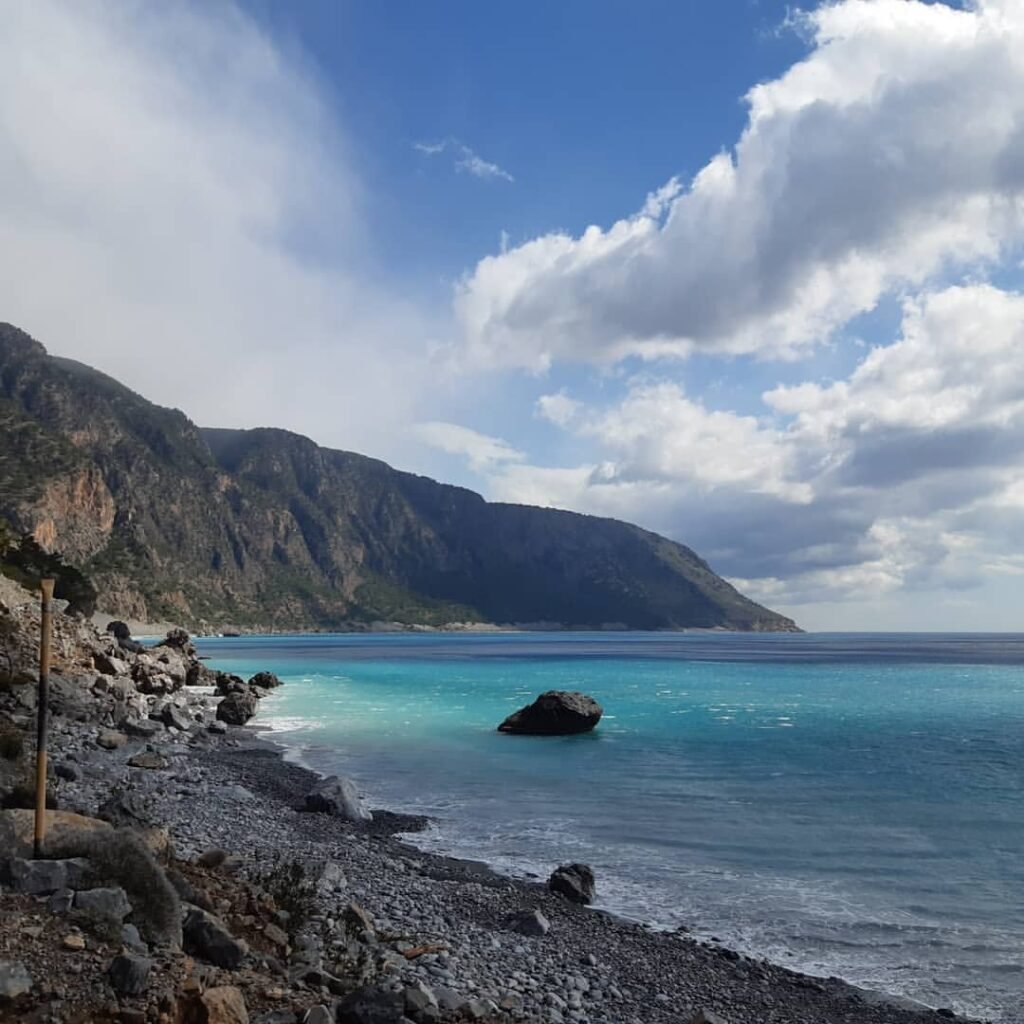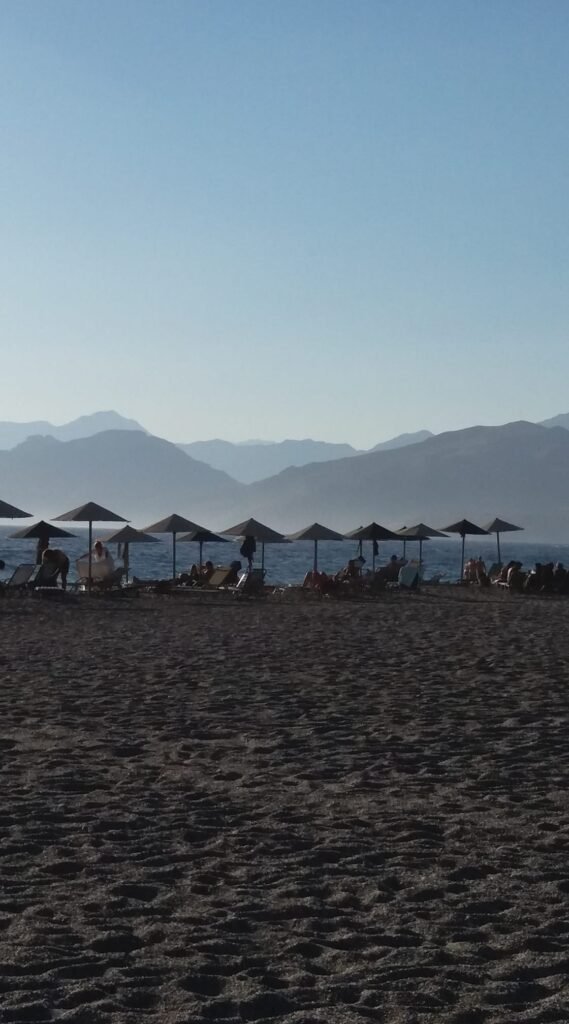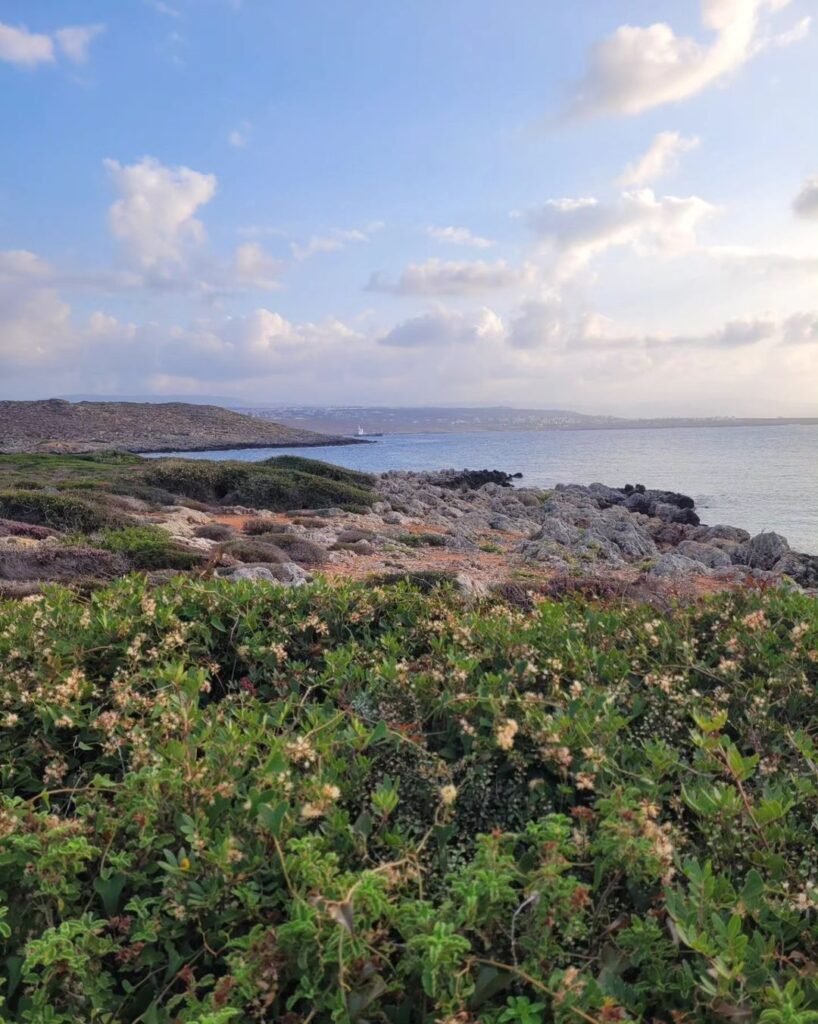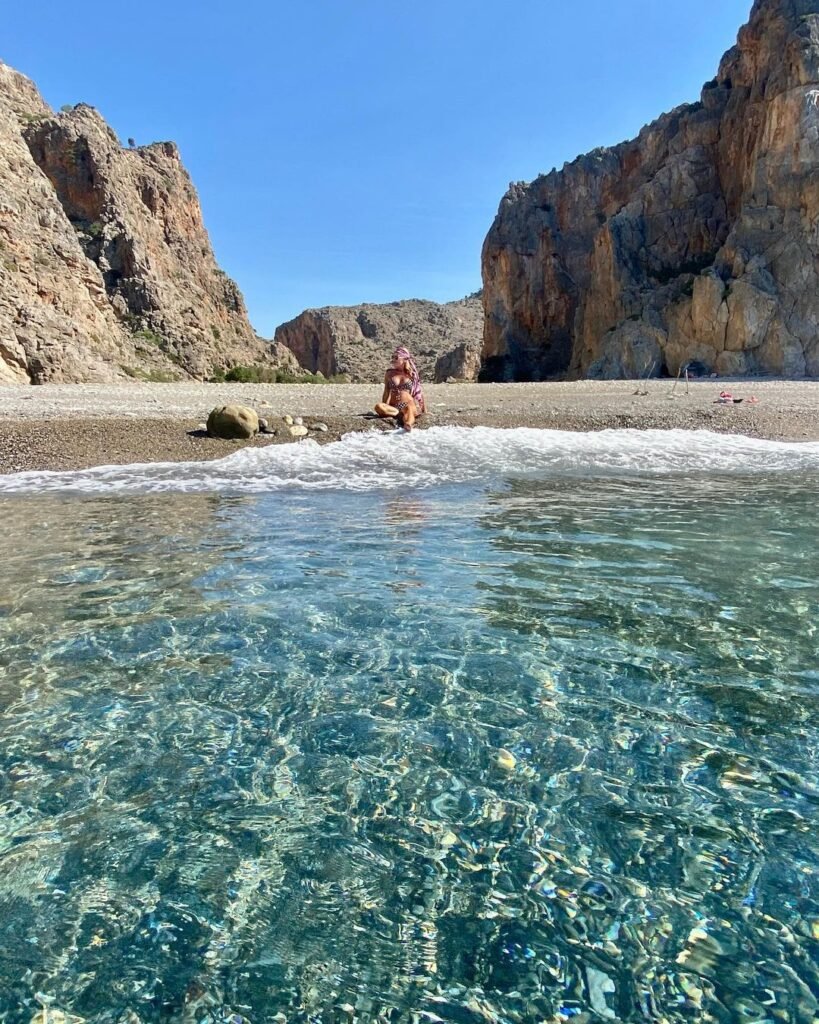Dreaming of a beach getaway where you can escape the crowds and enjoy some peace and quiet? Look no further than Crete! This stunning island is home to some of the most secluded and pristine beaches that many travelers don’t even know exist. So grab your beach towel and sunscreen, and let’s explore seven hidden gems across Crete’s beautiful regions that promise tranquility and natural beauty.
1. Seitan Limania (Chania Region)

Nestled in the rugged coastline of Crete’s Akrotiri peninsula, Seitan Limania (meaning “Satan’s Ports”) belies its ominous name with breathtaking beauty. Also known as Stefanou Beach, this hidden cove boasts striking turquoise waters embraced by dramatic, rocky cliffs.
The beach’s unique formation resembles a lightning bolt, creating three distinct inlets. The main beach, a small strip of white pebbles and sand, is flanked by steep limestone walls, offering a sense of seclusion and adventure.
Accessing this natural wonder requires a short but challenging hike down a rocky path. Wear sturdy shoes and be prepared for a bit of scrambling – the effort is well rewarded by the stunning views that unfold as you descend.
The crystal-clear waters of Seitan Limania are ideal for swimming and snorkeling, revealing a vibrant underwater world.

Wildlife enthusiasts will delight in the local fauna. Mountain goats, adapted to the rugged terrain, can often be spotted navigating the steep cliffs with impressive agility. Their presence adds a touch of wilderness to this already dramatic landscape.
History buffs will appreciate the cove’s intriguing past. During the Ottoman occupation of Crete, Seitan Limania served as a secret harbor, its concealed location making it ideal for covert operations and trade.
For the best experience, arrive early in the morning to secure a spot on this small beach and avoid the midday heat. Bring essentials like water, snacks, and sun protection, as there are no facilities at the beach itself.
While swimming in the cove is generally safe, be aware that the sea can become rough, especially when northern winds blow. Always check conditions before entering the water.
A visit to Seitan Limania pairs well with exploring the nearby Gouverneto Monastery or hiking to the cave church of Katholiko, both offering insights into Crete’s rich religious history.

2. Kedrodasos Beach (Chania Region)

Tucked away on Crete’s southwestern coast, Kedrodasos Beach is a hidden paradise that offers a serene alternative to the more frequented Elafonissi Beach. Its name, meaning “Cedar Forest” in Greek, hints at the unique landscape that awaits visitors.
This pristine stretch of white sand is framed by an enchanting forest of juniper trees, creating a natural canopy that provides welcome shade on hot summer days. The contrast between the azure waters of the Libyan Sea and the verdant greenery creates a mesmerizing spectacle.
Reaching Kedrodasos is part of the adventure. A short 15-minute hike from a nearby dirt road leads you through a scenic path dotted with aromatic juniper and pine trees. This slight seclusion helps preserve the beach’s unspoiled beauty and tranquil atmosphere.

The crystal-clear waters of Kedrodasos are ideal for swimming and snorkeling, with small coves and rocky outcrops adding interest to the shoreline. On calm days, the sea takes on a glass-like quality, reflecting the sky and surrounding landscape.
Kedrodasos is a favorite among free campers and nature enthusiasts, though it’s important to note that official camping facilities are not available. Visitors should practice “leave no trace” principles to help maintain the beach’s pristine condition.
For the best experience, arrive early in the morning to secure a shady spot under the junipers. Bring essentials like water, snacks, and sun protection, as there are no facilities on the beach itself.

Wildlife lovers might spot various bird species in the juniper forest, while the beach is occasionally visited by loggerhead sea turtles during nesting season.
While Kedrodasos remains relatively undiscovered, its proximity to Elafonissi means it can get busier in peak season. Visiting in late spring or early autumn offers the most serene experience.
3. Agios Ioannis Beach (Sfakia, Chania Region)

Nestled in the rugged Sfakia region of southern Crete, Agios Ioannis Beach is a hidden gem that rewards those willing to venture off the beaten path. This secluded cove, accessible by a scenic drive or an invigorating hike, offers a perfect blend of natural beauty and historical intrigue.
The dramatic backdrop of towering cliffs contrasts strikingly with the gentle lapping of the Libyan Sea, creating a postcard-perfect setting.
History buffs will appreciate the proximity to the ancient ruins of Lissos, once a thriving port city. A short walk from the beach leads to remnants of temples, a Roman theater, and a well-preserved Asklepieion (healing center), offering a glimpse into Crete’s rich past.

For the adventurous, Agios Ioannis serves as an excellent starting point for hiking trails that wind through the region’s gorges and valleys. The E4 European long-distance path passes nearby, offering opportunities for both casual strolls and more challenging treks.
While facilities are limited, this adds to the beach’s unspoiled charm. Visitors should come prepared with essentials, including water and snacks. For a taste of local flavor, the nearby village of Sfakia offers traditional tavernas serving Cretan specialties like sfakiani pita (cheese-filled pastry – this is a must-try!) and fresh seafood.
Its remote location ensures a peaceful atmosphere, making it ideal for those seeking to escape the crowds and connect with nature.

4. Triopetra Beach (Rethymno Region)

Located in the southern part of the Rethymno region, Triopetra Beach is named after the three distinctive rock formations that emerge from the sea, creating a unique and picturesque landscape. This expansive beach stretches for over a kilometer, offering plenty of space for visitors to find their own secluded spot away from crowds.
The beach is divided into two main sections: Mikro (Small) Triopetra and Megalo (Large) Triopetra. Mikro Triopetra is more organized, with sunbeds, umbrellas, and a few tavernas, while Megalo Triopetra offers a more natural and untouched environment.
Triopetra’s crystal-clear waters make it ideal for swimming and snorkeling. The beach is known for its stunning sunsets, where the sun appears to sink directly into the Libyan Sea, creating a mesmerizing spectacle of colors.

For the more adventurous, Triopetra offers excellent conditions for windsurfing and kite surfing, especially during the afternoon when the winds pick up. The beach’s western orientation also makes it a popular spot for fishing enthusiasts.
Triopetra Beach has gained recognition as a haven for yoga retreats, thanks to its tranquil environment and breathtaking views.
The beach is easily accessible by car, about an hour’s drive south from Rethymno town. The journey itself is part of the experience, offering scenic views of the Cretan countryside and traditional villages.

Nearby tavernas serve delicious local cuisine, specializing in fresh fish and traditional Cretan dishes. Don’t miss the opportunity to try some local specialties like dakos (Cretan rusk topped with tomato and feta) or kalitsounia (small cheese pies).
For nature lovers, the nearby Kedros Mountain offers hiking opportunities with panoramic views of the Libyan Sea and the surrounding landscape. The small village of Triopetra, located just above the beach, provides a glimpse into traditional Cretan life.
5. Voulisma Beach (Lasithi Region)

Nestled in the Lasithi region near the charming village of Istro, Voulisma Beach, also known as Golden Beach, offers a perfect blend of accessibility and tranquility. This crescent-shaped cove lives up to its nickname with its fine golden sand that gracefully meets the crystal-clear turquoise waters of the Mirabello Bay.
While more accessible than some of Crete’s hidden gems, Voulisma still provides a quieter experience compared to the island’s more bustling beaches. Its shallow waters make it an ideal spot for families with young children, offering safe paddling and swimming opportunities.

The beach is embraced by gently sloping hills covered in ancient olive groves, creating a picturesque backdrop that epitomizes the Cretan landscape. These surroundings not only add to the beach’s aesthetic appeal but also provide opportunities for short, scenic hikes with rewarding views over the bay.
Voulisma Beach offers basic amenities including sunbeds and umbrellas for rent, and a few nearby tavernas serve fresh local cuisine. For those seeking a more secluded experience, the beach’s generous size allows for quieter spots away from the main area.

Best visited in the morning or late afternoon to avoid peak hours, Voulisma Beach captivates with its stunning sunsets, as the fading light paints the sky and sea in vibrant hues.
Whether you’re looking for a family-friendly beach day, a romantic seaside stroll, or simply a place to unwind amidst beautiful surroundings, Voulisma Beach offers a slice of Cretan paradise that balances natural beauty with comfortable accessibility.


6. Macherida Beach (Chania Region)

Tucked away near the charming village of Tersanas in the Chania region, Macherida Beach is a hidden gem that captures the essence of Crete’s unspoiled coastal beauty. This small, secluded cove is a sanctuary for those seeking tranquility away from the island’s more frequented shores.
Macherida, which means “knife” in Greek, likely gets its name from the sharp, rocky outcrops that frame the beach, creating a dramatic and picturesque setting. These rocky formations not only add character to the landscape but also provide natural shelter, making the beach a calm haven even on windier days.

The beach’s clear, turquoise waters are a snorkeler’s delight, offering visibility that allows for exploration of the diverse marine life inhabiting the rocky seabed. The mix of sand and pebbles underfoot adds to the beach’s natural charm and helps maintain the clarity of the water.
While facilities are limited, this only adds to Macherida’s appeal for those looking to escape the trappings of more developed beaches. Visitors should come prepared with essentials like water, snacks, and sun protection.

A short walk from the beach leads to elevated spots perfect for panoramic views of the coastline and the endless blue of the Cretan Sea.
Macherida’s off-the-beaten-path location means it rarely gets crowded, even during peak season. It’s a favorite among locals, which speaks volumes about its beauty and serenity. Visitors might find themselves sharing the beach with only a handful of others, creating an intimate connection with nature.

For those interested in exploring beyond the beach, the nearby village of Tersanas offers a glimpse into traditional Cretan life, with its narrow streets and local tavernas serving authentic island cuisine.

7. Agiofarago Beach (Heraklion Region)

Nestled in the Heraklion region of Crete, Agiofarago Beach offers a unique blend of natural beauty, spiritual history, and adventure. This secluded haven is accessed via a captivating 30 to 40-minute hike through the Agiofarago Gorge, aptly named the “Gorge of Saints” in Greek.
The journey to Agiofarago is as rewarding as the destination itself. The trail winds through a landscape steeped in spiritual significance, once a retreat for ascetic monks and hermits. Hikers will encounter numerous caves and small chapels carved into the cliff faces, silent witnesses to centuries of contemplation and devotion.

As you traverse the gorge, the Cretan flora unfolds in a tapestry of aromatic herbs, hardy shrubs, and weathered trees, offering glimpses of the island’s rich biodiversity. Keep an eye out for the elusive kri-kri, Crete’s native wild goat, which sometimes frequents these remote areas.
The gorge eventually opens up to reveal a pristine beach framed by towering limestone cliffs. The contrast between the rugged landscape and the serene, turquoise waters of the Libyan Sea is truly breathtaking. A small, whitewashed church near the shore adds to the beach’s tranquil atmosphere, its presence a reminder of the area’s enduring spiritual legacy.
Agiofarago’s crystal-clear waters are perfect for swimming and snorkeling, with the surrounding cliffs creating a natural swimming pool effect on calm days. The beach itself is a mix of sand and small pebbles, ideal for sunbathing or meditation.

While facilities are limited due to its remote location, this only adds to Agiofarago’s unspoiled charm. Visitors should come prepared with water, snacks, and sun protection. The lack of amenities ensures that the beach remains peaceful and pristine, even during the peak summer months.
For the adventurous, the cliffs surrounding Agiofarago offer excellent climbing opportunities, with routes suitable for various skill levels. Always ensure you have proper equipment and experience before attempting any climbs.
As you relax on the beach, you might spot the occasional monk making their way along the shore, a living link to the area’s sacred past. This juxtaposition of ancient spirituality and natural beauty creates a uniquely contemplative atmosphere.

Wrapping Up Your Beach Adventure
These beaches in Crete are more than just picturesque spots; they offer a retreat from the hustle and bustle, allowing you to connect with nature and enjoy the island’s stunning landscapes in peace. Whether you’re an avid beachcomber or just looking for a serene spot to unwind, these hidden gems promise a memorable escape. So pack your bags and get ready to discover Crete’s best-kept secrets!

